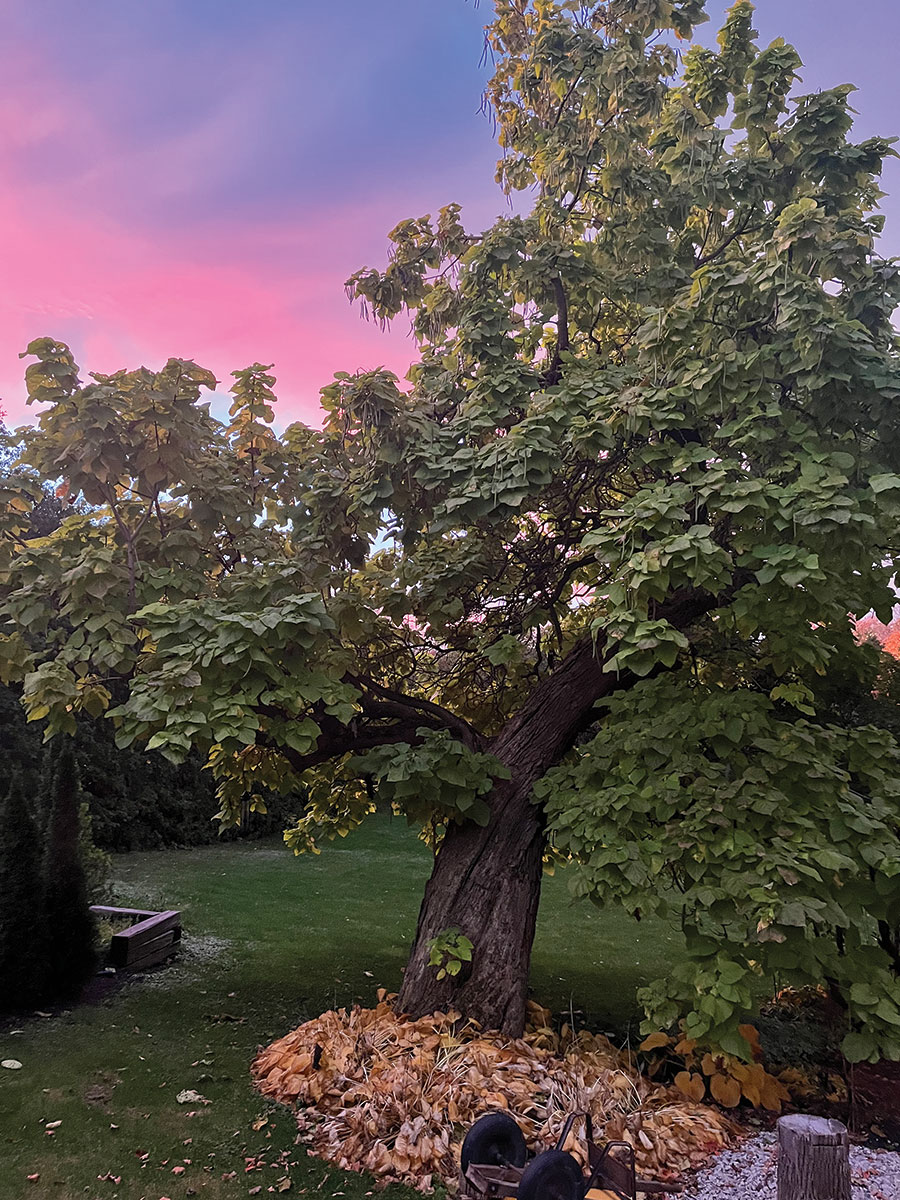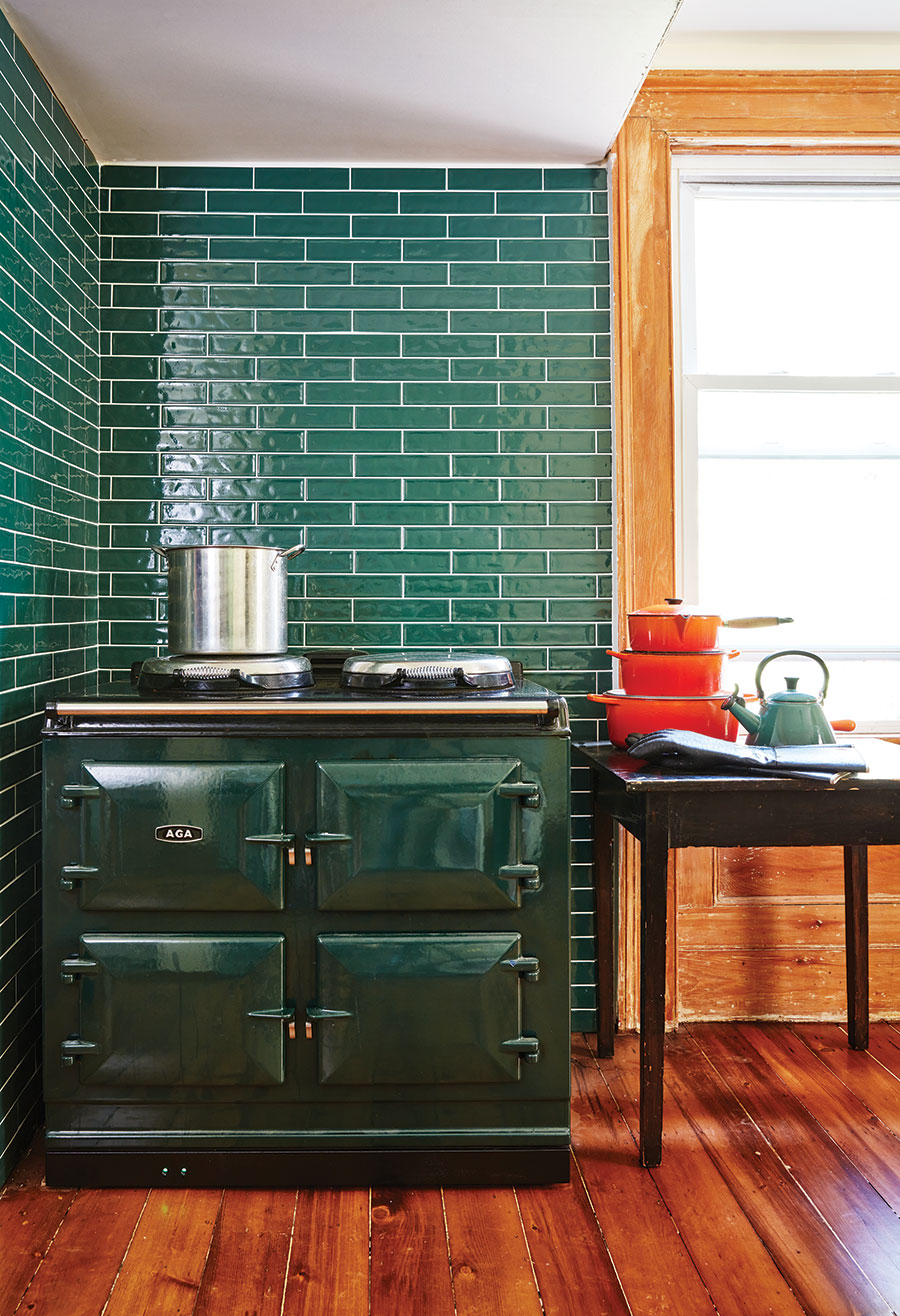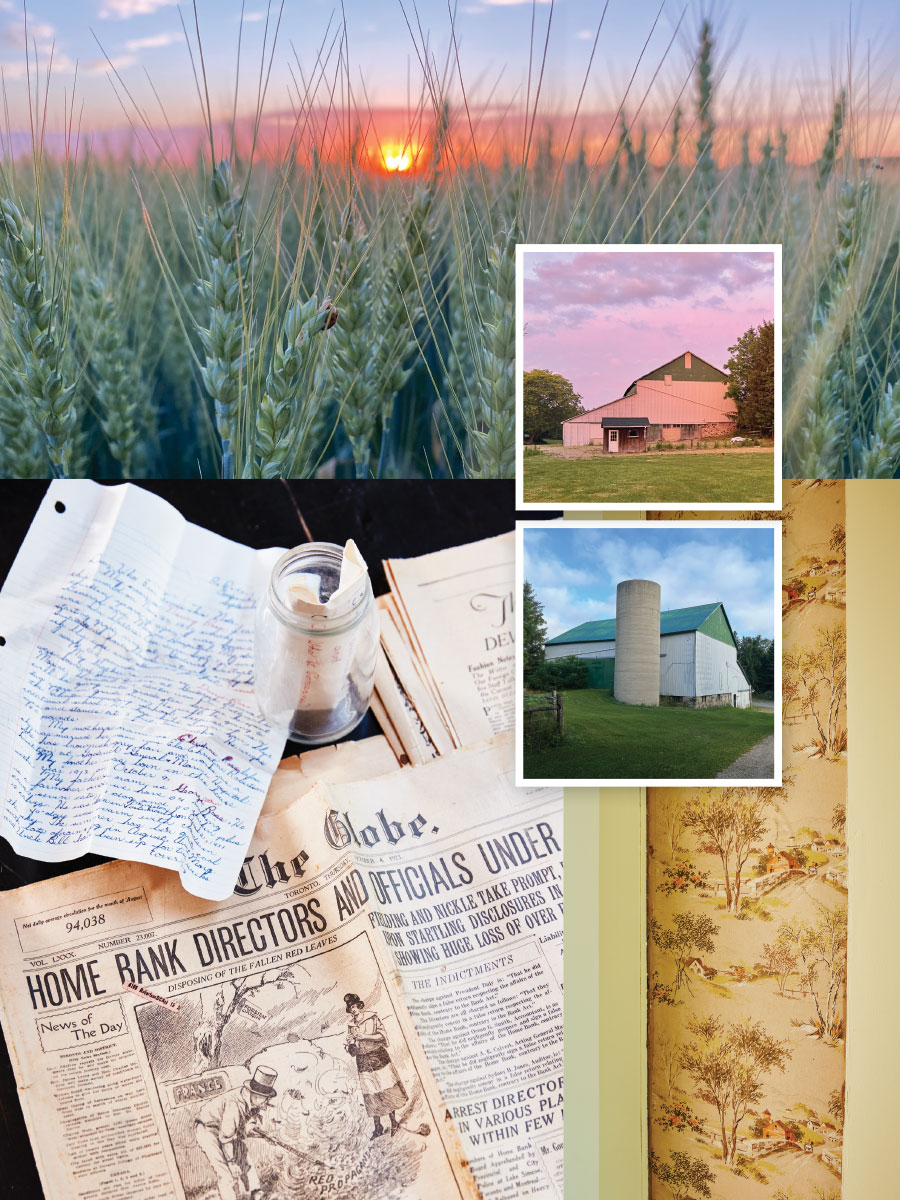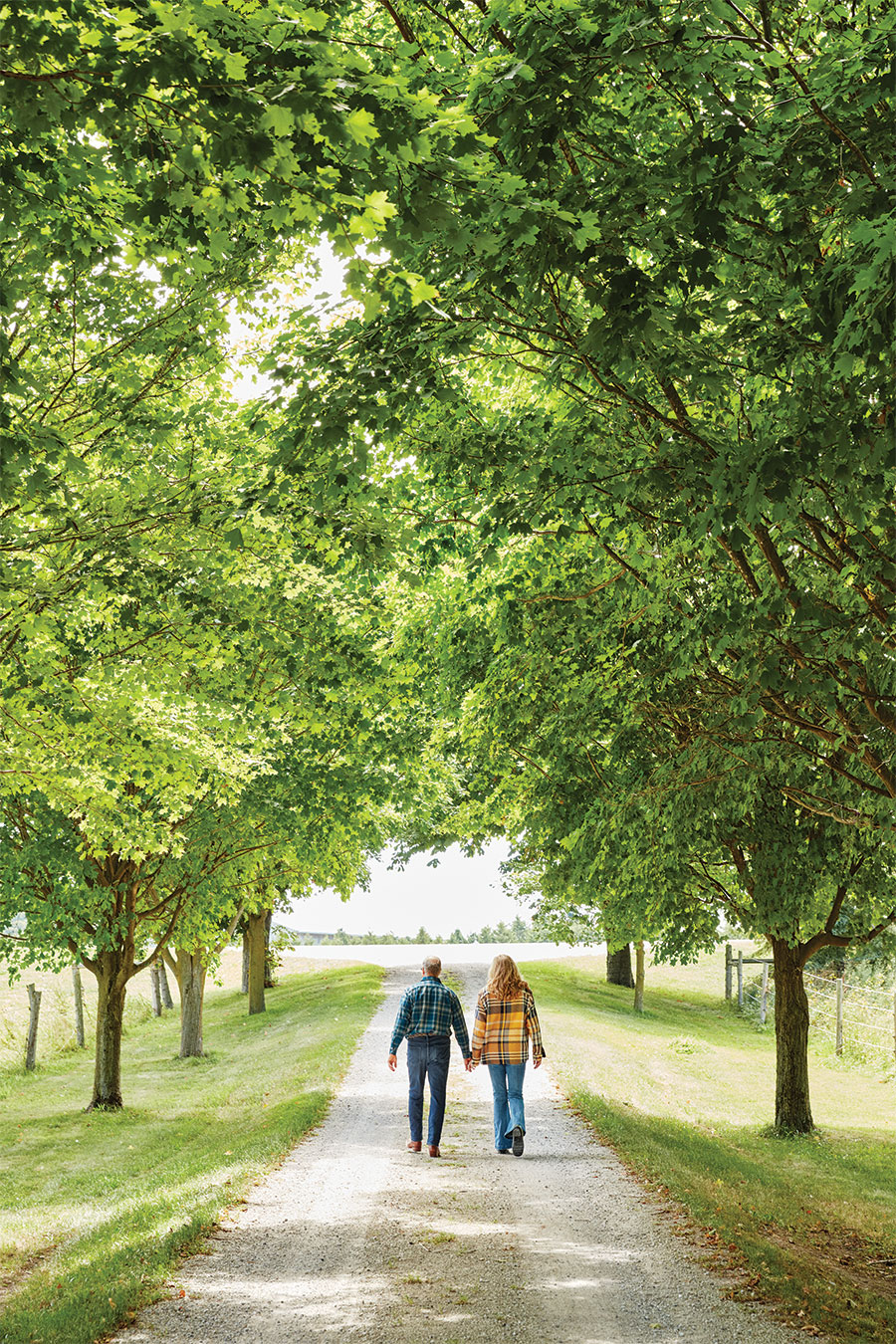How a Farm in the Country Gave a Toronto Couple the Space to Imagine Their Post-Retirement Future

The author and her husband Bob. Photo: Leanne Delap
A magnificent Catalpa presides over our farm. The 60-year-old tree, centred in front of the wraparound porch, is a stunner in all seasons: delicate white blossoms in late spring; lush, oversized leaves offering deep shade in the heat of summer; and a stripped-down, witchy, cantilevered sculpture in winter, with dangling seed pods miraculously intact despite the fierce winds that sweep across the rolling farmer’s field next door. This ornamental beauty looks out of place here in rural Ontario, but its roots run deep in the soil now.
I often wonder how we blend in here in Huron County, a 2.5-hour drive west of our home in Toronto. I’m a writer and editor who spent decades following the fashion circus around the world; my husband is a Bay Street lawyer. We bought this century-old farm, which sits on 13 acres (just over five hectares) in Alice Munro country, in 2021. (The Nobel Prize-winning Canadian author grew up in nearby Wingham, Ont., and spent her later years writing, just a stone’s throw away, in Clinton.) The farm came with a giant barn and paddocks that I yearn to fill; various sheds, including a cute little one the previous owner used to hang deer, and which I’ve earmarked for pickling and fermenting; a big, natural pond and a series of cascading man-made ponds; and a massive cement grain silo that stands like a sentinel at the end of a long drive flanked by mature chestnut trees. The sunrises and sunsets are otherworldly outbursts. A carpet of thousands of daffodils marks spring as if the grounds have been coloured in with a yellow highlighter, followed by an embarrassment of lilac blossoms and pink and white peonies, then on to the subdued oranges and reds of the dahlias and daylilies that bloom in late summer.
I walk our property each morning, trying to memorize its contours the way you memorize a lover’s body with your hands. But, unlike a human who ages and changes in microscopic increments, this farm makes a new map every day, because nature is always ready to reclaim the wilderness it ceded when the land was cleared.

A farm is a romantic notion, sure, and I’ve spent decades driving by farmhouses and feeling a yearning in the pit of my stomach. But I’m 55, and my husband, Bob, is nine years older. Hobby farming is a young person’s game, because even if we aren’t plowing the acreage, it is backbreaking work. Just maintaining a property this size means many more chore hours than reading hours.
Bob and I married later in life and we have different hobbies, sets of friends and even rhythms: I’m an early bird; he is a night owl. I have long been terrified of my husband’s looming retirement. He has a few high-octane years of work still ahead, but for a life transition this big, especially when our timetables are a decade out of sync, we had to imagine a future with a challenging joint project. And it all needed to happen gracefully, well ahead of his last day at the office.
In general, my husband is the planner in the relationship, which is the reason we have retirement options to fret about in such a privileged way. Also, we are lucky enough have a house in downtown Toronto, so we aren’t going full Green Acres without a city option and backup plan.
Arriving at this decision meant weighing a lot of factors beyond the emotional pull to the country. My vision of the future doesn’t include a formal cessation of work, since writers type until they keel over. I can work from anywhere, and I prefer a lot of time alone to do so. Thus, I like the arrangement as it is: Bob going off to his big office in the clouds every Monday and me spreading out as I work from home. I just can’t imagine having him in my lap every day from dawn to dusk, puttering around while I chew my pencils to the nub.
But how would this new rural life take shape with one of us still working? I’m not used to a lot of actual time with my husband, because lawyers work long hours and do a lot of business development (a.k.a. work socializing). Bob’s eventual retirement will mean going from a couple of nights and the weekend together to 24/7. Thus, we needed more space, a lot more space. And we needed to learn to do stuff together.
Compromising on how to build this new life together has been easy and hard. We found the farm on his birthday, making an offer within an hour, even though it was the first place we visited. (Not such a stretch for me, but a big change for Bob, who can take a year to buy a sports jacket.) Blending families is hard at any age: We had grand ideas about creating a gathering place for our combined five children; we wanted someplace new, where everyone had a hand in creating memories.
Planning for the next stage was spurred at the very beginning of the COVID-19 pandemic by an Atlantic story that is wedged in my mind. Columnist Arthur Brooks, who has a podcast called How to Build a Happy Life, advocated recasting retirement as a continuum of our personal narrative. He uses the Jungian mythology of the three-part Hero’s Journey to explain the arc of a career: dream, suffer and sacrifice, savour victory. But it is part four, which Brooks calls “the personal crucible,” that is the bit most of us forget about when we tell ourselves the stories of our lives. “If you try to hang on to glory, or lash out when it fades, it will squander your victories and mark an unhappy end to your journey,” he wrote, adding one must “make tangible plans now to show true strength and character in the final phase.” In other words, you need to craft a new narrative. Happiness in retirement is something you have to put just as much effort into as your career.
When researchers at Harvard Business School conducted the Retirement Transitions Study, among the questions they posed were, in simpler terms: Who am I now? and when people ask me what I do, what do I tell them? Professor Teresa Amabile, who was semi-retired when the study was published in 2019, writes: “Work is such a huge part of our identity. Retirement untethers us from how we think of ourselves in a fundamental way.” The study’s results include the need to compromise with one’s partner, consider what you will do all day after retirement, and endeavour to find meaning in those activities. Sounds simple enough, huh?
To be fair, this is all my angst, because I’m not the one who is retiring. Bob has been clear about looking forward to the next stage. He has always said his career does not define him and the only thing he’d need to be happy in retirement is a library card. He works very hard, is very disciplined, and sees his retirement as his reward, but I do not want to put words in his mouth, so I interviewed him and remarkably he played along.
I asked him if he was okay with my farm plan, as he had always dreamed of a cottage. “It turns out my wife was right. Though a cottage property would have been lovely and I love the water, we could never have achieved this feeling of space and activity.” He added that he had come to view the farm as “a source of peace, a place to be productive and, most importantly, a part of our lives together in the future.”
Bob pointed out that I really should have adjusted to the idea of his retirement long ago, like, say when I made the decision to marry him five years ago. (Easier said than done, buddy.) “I prefer to think of this as just a change in direction” he said. “I’ve been at a corporate desk job and have spent a lot of the last 40 years between my ears. The farm enables me to tromp around in my boots and get concrete stuff done.” We’ve both learned he yearns to be physically busy, and loves to be covered in mud and axle grease. The real challenge, he said, “is to convince my wife I’m not slowing down, just changing gears.”
Two years ago, I came home from the market to find Bob on a ladder halfway up the eight-metre (26-foot) cedar hedge that runs around the house, which provides both privacy and a buffer from the wind. He was excited. “I’m thinking of renting a cherry picker,” he hollered. Um, sure honey, why? “To rip out these invasive vines at the top.” Suit guy had gone rogue. This was before he discovered the ride-on mower, and before I discovered the demented glee on his face as he hauled logs in the trailer he bought to go with it.
Renovating and decorating was daunting; opening up an old farmhouse is the definition of folly. The floorboards, hidden under lifetimes of linoleum, were swoon-worthy, but to keep that wide-plank vibe, we had to accept sloped floors. We went for pretty and restored, over new and straight. As for decorating, because everything is just a little crooked, Instagram-popular farmhouse white would have been a disaster. Instead, we went for a Clue theme: Mrs. Peacock hallway to match the blue of Lake Huron just a few kilometres away, and peacock wallpaper in the bathroom; many shades of Mr. Green for the kitchen, including the 500-kilogram (1,100-pound) British Racing Green AGA cooker I had shipped over on a boat from England; Colonel Mustard gold for the living room and hall and Professor Plum for the library. The upstairs bedrooms are all Easter egg pastels.


We had no trouble deciding on the big splurges: the AGA stove and an in-ground swimming pool for me, and a substantial fieldstone fireplace for him. However, filling up the place was harder than it should have been, even though I have been collecting treasures for a theoretical farmhouse for years. When Bob and I moved in together eight years ago, we filled dumpsters of castoff belongings from our separate houses in order to merge. Then we lost a full slate of parents, and inherited stuff commingled with ours. Not to mention five kids moving in and out as they launched and relaunched, with all their childhood belongings shuffling in all directions. Thankfully, we managed to purge what we didn’t want, and things are still quite spare here. I am happy moving on to the next stage with less baggage, literally and figuratively.
The uncluttered rooms leave us the mental space to focus on adjusting to rural life. I was worried I would miss the city, but now it’s hard to get me to town; only friends and hair appointments warrant the drive. For someone whose identity was forged as a downtown girl for so long, it’s amazing how effortlessly that has fallen away. I was worried about staying alone in the big empty house, but that serenity is now one of my favourite bits. I shrug off the occasional dramatic bump in the night, like the barn door slamming in the wind, coyotes facing off in the front yard or 3 a.m. activity at the chicken farm two fields away that looks and sounds like an alien landing; I still don’t know why they use searchlights, but I sleep through it now. Like Bob, I’m finding it feels good to be capable. I confidently shoo away the great blue heron who sits in the willow tree, waiting to swoop down and steal my fish, Charles, from the koi pond. I have rescued barn cats from live traps and fended off raccoons with distemper and bats stuck in the carport. Don’t get me started on the red squirrels.
It takes a village, and we have a platoon of experts to keep us humble: We have a Critter Guy (his actual company name, he live-traps bats, squirrels, raccoons and heaven knows what else), a mouse-and-pest guy, a well-water guy, a septic guy, a pond guy and a solar panel guy. When the dairy farmer down the road made a comment about our encroaching thistles, we thought we had made some grave rural faux pas and the plants were threatening their barley crop. It turns out she just meant we’d have a beast of a time getting them out if we didn’t stay on top of them. Thistle removal is now on the early-summer maintenance list.

SNAPSHOTS OF RURAL LIFE: Clockwise from top: the barley field at sunset; the farm’s barn and silo; the original wallpaper; notes and a newspaper found in the farmhouse walls. Photos: Stacey Brandford; Insets (barns): Leanne Delap
Space, we’ve learned, is the greatest of luxuries. I now identify with the passionate moments when fictional heroes declare their love for a property, from Duddy Kravitz to Scarlett O’Hara to the Duttons of Yellowstone. Land is tangible and the farmhouse feels solid. We are only the third family in more than 100 years to live here, which makes my husband teary. Each family has been a steward of the land; the last owner was a landscaper who carved a lush oasis out of a farmer’s field. His father, who planted the catalpa, had a talent for trees, and he created a magical woodland with unexpected treasures.
But it is the profound privacy that has changed me. My pandemic story involves caregiving for, and losing, my beloved mother, and then being forced to look after a cascade of end-of-life affairs for the father I had been estranged from, by my choice, for most of my lifetime. That last one messed with my head; I disintegrated, and withdrew to process a trunkful of trauma. This place showed me a way back; the stillness enabled my stillness.

As Bob said: “All I see here is potential. We will never run out of happy projects.” That is intoxicating. Should we get chickens or cows, or both? Build a rose garden? Produce artisanal butter? What about a field of sunflowers? Nothing cracks open the mind and heart more than land to pour your dreams into. After a long period of personal and universal stagnation and fear, it is exhilarating to be so excited about life and plans, and get up in the morning stoked to do productive, satisfying things together. Buying this place was an act of faith, but by taking the leap, we created a refuge. As I look at the big, wide veranda, I realize what we really bought was a cliché: a porch to sit on and grow old together.
A version this article appeared in the June/July 2023 issue with the headline ‘Dream House’, p. 66.
RELATED:
A Force of Nature: Marilyn Lightstone On Her Most Iconic Roles and Multifaceted Second Act
Second Acts: Canadian Entrepreneur Maggie Fox, 50, Shares Her Tips for Success